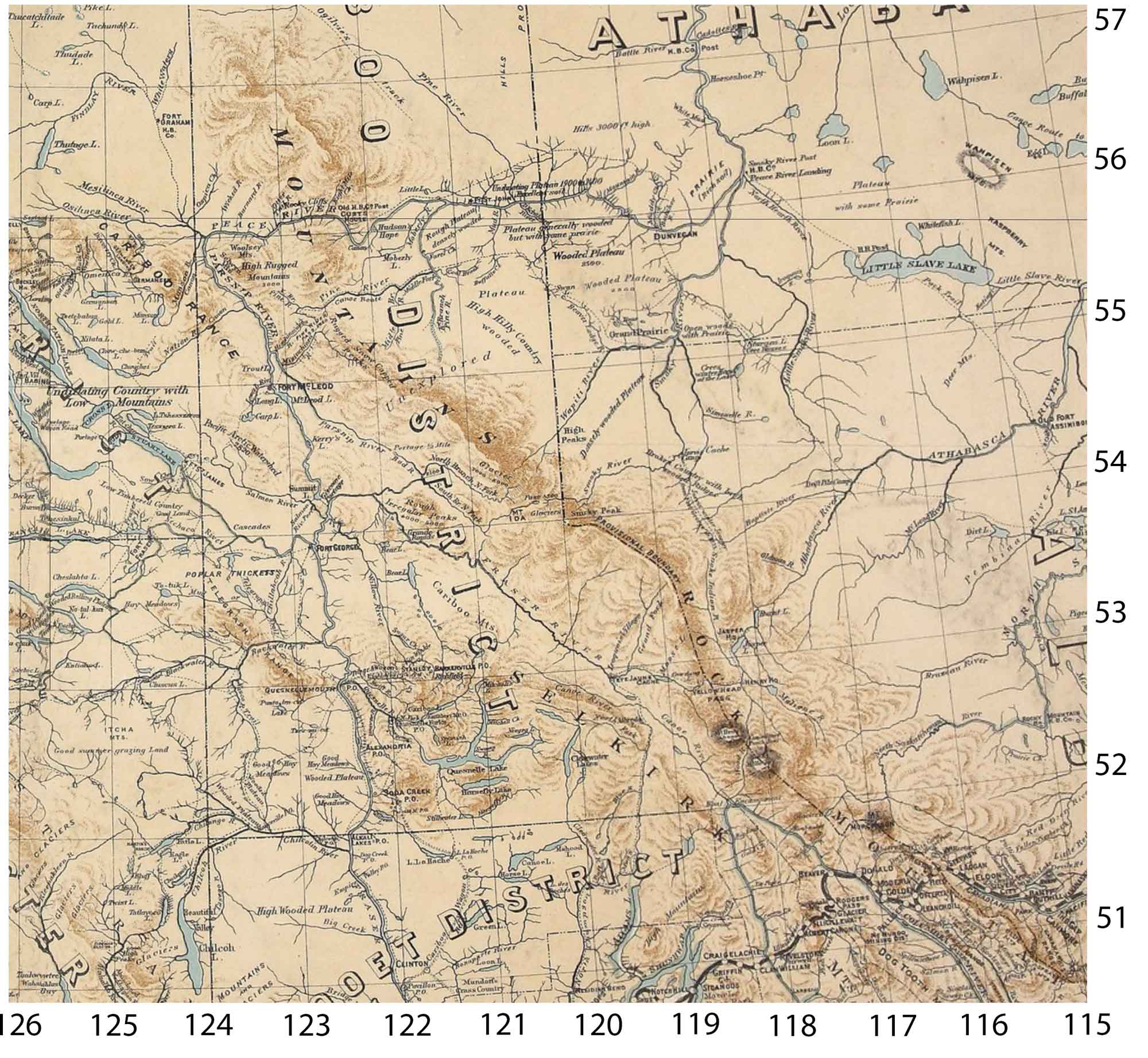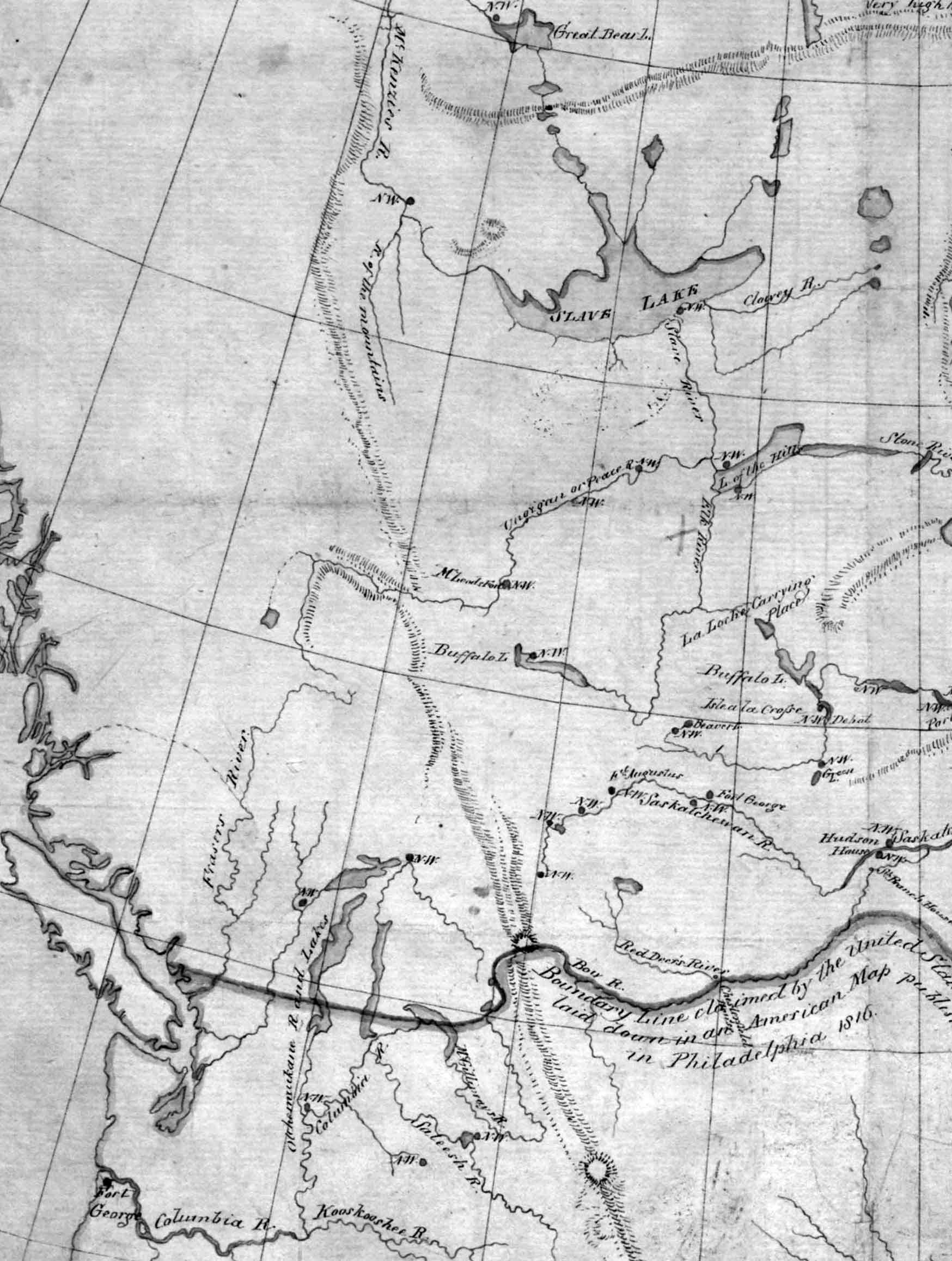Former name of Intersection Mountain
53.8 N 120 W — Map 93H/16 — Google — GeoHack
Official in BC – Topo map from Canadian Geographical Names

Map of the Province of British Columbia. Compiled by J. H. Brownlee, D.L.S., from the latest Maps and Surveys and all reliable sources of information to date.
UVic Libraries

Detail of map of BC compiled by J. H. Brownlee, D.L.S.
UVic Libraries
Map of the Province of British Columbia.
Compiled by J. H. Brownlee, D.L.S.
From the latest Maps and Surveys and all reliable sources of information to date.
By direction of
The Honourable F. G. Vernon,
Chief Commissioner of Lands and Works.
Victoria, 1893.
Lithographed by the Canada Bank Note Co. Limited, Montreal.
Physical repository: National Archives (Great Britain)

The First Canadian Pacific R.R. and Geological Survey parties for British Columbia, July 22 1871 Left to right : L. N. Rheaumis, Roderick McLennan, A. S. Hall, West West Ireland, Alfred Selwyn, Alex Maclennan, Walter Moberly, C. E. Gilette, James Richardson, — — McDonald, George Watt.
Toronto Public Library
Walter Moberly, C.E., L.S.
b. 15 August 1832 — Steeple Aston, Oxfordshire, England
d. 14 May 1915 — Vancouver, B.C.
In 1865, he was appointed assistant surveyor general of the Colony of British Columbia. His job was to explore new routes for travel and trade for the growing population of the territory. It was during this time that he discovered Eagle Pass through the Gold Range between Shuswap Lake in the north Okanagan and the Columbia River at what is now Revelstoke. The story is that he shot at an eagle’s nest and watched the birds fly up a valley. Reasoning that the birds were unlikely to fly up a blocked valley, he followed them up and discovered the pass. In his recollections, he says he blazed a tree in the pass and inscribed the words, “This is the Pass of the Overland Railway.” The Canadian Pacific Railway did go through his pass but not for another 20 years.
After 1865, he left the province and worked in the mining fields of Utah.
In 1871, when British Columbia was about to enter Confederation with Canada, one of the terms was a promise by Canada to build a railway across the continent. Moberly was sought out by Sir Joseph William Trutch, British Columbia’s first provincial Lieutenant-Governor, and invited back to organize surveys for the railway. His survey crews headed out into the wilderness on the day the province joined confederation. Moberly’s survey crews were responsible for the territory around what is now Eagle Pass, Revelstoke, and Golden. From the time of his discovery of Eagle Pass, he formed the conviction that this was the best route for the railway. However, Sir Sandford Fleming, F.R.S.C., K.C.M.G., chief engineer of the railway project, asked Moberly to relocate his crews north to the Yellowhead Pass for the 1872 season. Moberly was very frustrated with these orders requiring him to abandon his preferred route.
After the 1873 survey season, Moberly left the Canadian Pacific Survey and moved to Manitoba. He continued to do private survey work there. Moberly retired in Vancouver after 1898 and died there in May 1915.
In 1871 Rylatt was recruited by fellow Royal Engineer veteran Walter Moberly [1832–1915], who was in charge of S party of the Canadian Pacific Railway Survey. Rylatt served as quartermaster for the party until 1873, when he got word that his wife had died. He wrote a memoir of the trip for his family, now published under the title Surveying the Canadian Pacific — Memoir of a Railroad Pioneer[1].
Upon starting, our party consisted of 4 officers (surveyors), 16 men, principally axeman about one half of them Canadian, 8 Mexican and Indian Packers, and one hunter for the party — a Bavarian. There were 45 animals in the Pack Train, each carrying about 300 pounds.
S Party spent winter 1871-72 on the Columbia River near the Blaeberry River at the west end of Howse Pass. Moberly, who had spent the winter in Ottawa, arrived at their camp on June 16th. The ‘S’ party spent the entire season moving their equipment, supplies and pack trains through the Athabasca Pass, and north, arriving in January at the east end of the Yellowhead Pass, which Rylatt consistently called the Leatherhead Pass. On May 13, 1873, Rylatt set off through the Yellowhead Pass with one companion and three horses, reaching Kamloops on June 14. Rylatt continued on by stage to his home at New Westminster.
And now, my reminiscence is done. I might go on to state I found an empty house, my goods intact but stored in a ware-house. My return to my empty home, and the replacing of everything therein as it used to be in the days that were gone. My sad thoughts as l lay stretched upon the bed my poor wife had breathed her last upon. My many visits to her grave, and my final sale of home and belongings, and my wandering away to seek another home, under another government. But to what end?
Robert M. Rylatt
On the 2d November (my birthday by the way), I reached the depot

Map of Indian Territories to accompany the report of the Coltman mission. William Sax, 1818. The red horizontal line is “Boundary line claimed by the United States as laid down in an American map published in Philadelphia 1816.” Library and Archives Canada [accessed 19 February 2025]

North America. The continent west of the Great Lakes north of about 45°N. Detail Library and Archives Canada [accessed 19 February 2025]

Detail of Peace River Library and Archives Canada [accessed 19 February 2025]
William Sax [1774–1840], First Clerk in the Surveyor General’s Office of Canada, was active ca. 1795 – 1835. He drafted this map to accompany the 1818 report of William Bacheler Coltman, commission of the peace for the Indian territory of the northwest, regarding the struggle between the Hudson’s Bay Company and the North West Company for hegemony in the fur trade.
Walter Alfred Don Munday [1890–1950]
b. 1890 — Portage la Prairie, Manitoba
d. 1950 — Vancouver ?
Walter Alfred Don Munday was a Canadian explorer, naturalist and mountaineer famous for his explorations of the Coast Mountains with his wife Phyllis Munday [1894–1990], and especially for the exploration of the Waddington Range.

Survey of Telegraph Creek and upper part of Shuswap River near Tete Jaune Cache, May 1865 University of Victoria
The Colonial Despatches of Vancouver Island and British Columbia 1846-1871, Edition 2.4, ed. James Hendrickson and the Colonial Despatches project. Victoria, B.C.: University of Victoria.
In 1864
Tête Jaune Cache
Cranberry River
Swamp River
Bear River
Fraser River
Fur-trading district.
From Merk’s introduction to Fur Trade and Empire:
The accompanying journal of George Simpson [1792–1860] is a memoir of trade and of empire. The author was Governor of the Hudson’s Bay Company Territories in America, and as such, director of the economic life of the greater part of what is now the Dominion of Canada and the Pacific Northwest of the United States. At the time of writing this journal he was primarily interested in the task of rehabilitating the fur trade of one section of this vast empire, the Oregon Country, stretching westward from the Rocky Mountains to the sea and from California to Alaska. His account opens with his embarkation in a North canoe on Hudson Bay bound for the Pacific and for the work of reorganizing this trade. He gives a lively narrative of his swift journey across the continent, with comments interspersed on the state of trade along his route. In Oregon the record becomes a memoir of Indian life, of trade problems, of the slashing reforms by which he revived a demoralized and profitless industry, and of his plans for holding possession of the country against any future competition of Americans.…
The Oregon Country, which is the central theme of the document, was in 1824-25 a region in dispute. Not only was it contended for by Great Britain and the United States, but it was claimed also by the Russian Czar, though he was preparing in 1824-25 to give up such rights as he had there for recognition of his sovereignty north of the parallel of 54° 40′. Governor Simpson was ambitious to win the Oregon Country, or as much of it as possible, for Great Britain and for the Hudson’s Bay Company.
Peace came by way of a coalition agreement entered into in London in 1821. In the merger the Hudson’s Bay Company retained its identity; it took over the assets of the North West Company, evaluated like its own at €200,000, and to finance the consolidation doubled its outstanding stock. The charter and the ancient privileges of the Hudson’s Bay Company remained undisturbed. To the privileges a princely addition was made. The British government as a reward for the peace and as a means of preventing any future outbreak of war conferred upon the reorganized Company, under an act of Parliament of 1821, exclusive trading rights for twenty-one years in all that part of British North America lying between Rupert’s Land and the Rocky Mountains, and, in addition, the sole British trading rights in the whole of the Oregon Country. Thus the entire area which is now the Dominion of Canada excepting only the valley of the St. Lawrence and the maritime provinces was, after 1821, under the control of the Hudson’s Bay Company, either as proprietor or as possessor of exclusive trading rights, and besides the Company held sole British rights of trade in all of what is now the Pacific Northwest of the United States.
The Company divided this empire, for purposes of trade, into four great Departments. Of these the Northern Department of Rupert’s Land was the largest and most important, embracing the area lying between the Arctic Ocean on the north, the United States on the south, Hudson Bay on the east and the Rocky Mountains on the west, together with New Caledonia west of the mountains. The Southern Department extended from James Bay southward to the provinces of Upper and Lower Canada, and also East Main, the eastern slope of Hudson Bay. The Montreal Department comprised whatever business was done in the Canadas, and included the Kings Posts, and at a later date part of Labrador. The Columbia Department embraced the valley of the Columbia and after 1825 the province lying to the north of it — New Caledonia. Departments such as these were principalities! (1)